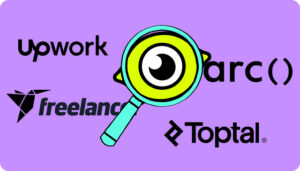You’ve heard the pitch a hundred times. Your project is behind, internal bandwidth is maxed, and someone drops the phrase “just bring in a few contractors.” They call it staff augmentation. Easy, right? Until your inbox fills with status updates, onboarding docs, and a familiar headache: Why does it feel like you hired more chaos than help?
Now add another layer: Managed services, outsourcing, “done for you” options. Suddenly, every agency and recruiter is promising what sounds suspiciously like the same thing—more hands on deck, less stress for you.
Except when things go wrong (and trust us, they do), it’s rarely because you picked the “wrong” model. It’s because nobody explained what you were truly buying—or what it would be like when trouble hits.
We’ve matched thousands of developers with companies big and small. If you’re still squinting at proposals trying to spot the difference between staff augmentation and managed services, you’re not alone. The confusion is real, and it matters more than you think.
So, let’s break it down: where staff augmentation trips up most teams, what makes managed services different (really), and how you can spot red flags before you’re stuck fixing the mess. Along the way, you’ll get stories from the only perspective that counts—the one cleaning up when things fall apart.
Ready for the real-life difference? Read on (and keep an eye out for what usually goes sideways, straight from the people who’ve remediated 2000+ hires).
Staff Augmentation: When ‘More Hands’ Means More Headaches
Let’s start with the basics, or at least what passes for “basics” in most sales decks. Staff augmentation, managed services, outsourcing—they all get tossed around at kickoff calls like interchangeable parts. The reality? They don’t mean the same thing, but you’d never know it from the way everyone uses them.
Staff augmentation is “add talent to your team, but you stay in charge.” You’re not handing over the car keys, just squeezing someone new into the back seat. You get more bodies, but all the projects, oversight, and headaches still belong to you.
Managed services flips this on its head: you pay a team not just to show up, but to own an outcome. It’s less “help us do work” and more “make the problem go away.” If staff augmentation offers you more hands, managed services try to deliver you a finished product (and maybe a warranty).
Outsourcing is a catch-all everyone uses when they’re tired of explaining the difference—sometimes it means staff aug, sometimes it means managed, sometimes it’s just a way to get off the call.
So why does this matter? Because mixing them up is the fastest way to get blindsided. Expecting plug-and-play simplicity from staff augmentation? Expect disappointment. Trusting managed services to read your mind? Cue finger-pointing and project drift.
But the real trouble starts after the SOW is signed. Here’s how staff augmentation usually goes sideways—and why most clients don’t see it coming.
When Staff Augmentation Goes Off the Rails
On paper, staff augmentation looks simple: bring in extra hands, crank out more code, and watch projects move faster. Reality check: without the right setup and mindset, it’s a recipe for friction, blind spots, and endless backtracking.
Ask anyone who’s cleaned up a failed aug project—they’ll spot the warning signs from a mile away. According to Malky Volodarsky, Head of Client Support at Lemon.io, “One of the first red flags? When a company puts their internal HR in charge.” What happens next is predictable: HR brings in their own network, KPIs, the “safe” faces they’ve worked with before. Suddenly, instead of a team, you’ve got what Malky calls an “HR mob”—and that’s when politics start trumping performance.
It’s rarely about bad developers. More often, good talent gets lost in a sea of internal turf wars, unclear expectations, or rushed onboarding.
Internal Turf Wars and Culture Clashes
It’s not just technical skills that derail a staff aug project—it’s office politics gone wild. When internal loyalties shape decision-making, external developers become outsiders fast, no matter how sharp they are. Suddenly, the “team” splits along familiar lines, and trust gets replaced with turf wars.
“HR departments aren’t the enemy, but they need to stay open and unbiased,” Malky adds. “When they operate in silos and treat external devs like temps or intruders, things break fast.” Sidelining, cliques, and suspicion creep in. Great contractors get benched for not being in the “circle,” and solutions get stuck in neutral.
The Onboarding Shortcut (That Costs You Later)
But even when HR’s not the culprit, lack of onboarding or alignment torpedoes plenty of promising starts. “Never, ever skip onboarding,” Malky insists. Rushing through the kickoff to “save time” usually costs teams much more down the road—lost trust, mismatched expectations, and rework that could have been avoided by spending an hour or two setting the table.
Swapping Developers Won’t Fix a Broken Process
Then there’s the myth that a quick developer swap will fix anything. In reality, if the problem is systemic—missing documentation, no clear process, fuzzy goals—fresh faces won’t save you.
As Malky puts it, “That’s the danger: excellence can be the enemy of good when there’s no process in place for context or continuity. The root issue isn’t the dev—it’s a lack of onboarding and alignment.”
Other warning signs?
- Projects with shifting requirements and no true oversight often spiral.
- Internal teams hoping external talent will magically “just fit” without any integration or feedback end up disappointed.
Most of these misses boil down to the same handful of mistakes: skipping context, treating people as interchangeable, and assuming more bodies equals more progress.
If you find yourself asking for daily updates but still feeling out of the loop, or watching great contractors cycle through without making real impact, odds are you’re facing one of these common pitfalls. Staff augmentation, mishandled, doesn’t just fail quietly—it drags everyone down with it.
So, how do you keep things on track and avoid these pain points? Let’s compare what managed services do differently, and why the right fit is about more than filling gaps on a Gantt chart.
Managed Services: Where Someone Else Owns the Headache (and the Results)
Staff augmentation asks you to be the conductor and hope the orchestra keeps tempo. Managed services, on the other hand, hand the baton (and the “please just get it done” stress) to someone else. You don’t manage the individual musicians—you order the performance and expect it to hit a certain standard.
At its best, managed services mean setting clear expectations, handing over a well-defined scope, and letting a third party deliver a finished product while you keep your inbox (mostly) free of daily “can you clarify this spec” messages. You’re not just getting hours, you’re buying outcomes—usually with a side of SLAs, timelines, and a single neck to wring if things slip.
But here’s where most clients get tripped up: assuming managed services magically eliminate all your problems. You still need to define what “done” means, communicate success criteria, and recognize that more control for the vendor means less for you. It’s not an “out of sight, out of mind” setup—it’s a partnership with clearer boundaries, but also real opportunity costs if you’re inflexible or vague.
Pros and Cons at a Glance
What Works Well |
Where It Can Go Sideways |
|---|---|
Clear ownership of deliverables |
Rigid contracts, less flexibility |
Outcome-focused partnership |
Big changes = extra cost |
Less day-to-day oversight needed |
Distance from developer decisions |
Predictable costs, often bundled |
Sometimes slower to adapt |
What Clients Usually Miss
Plenty of teams fall into the “set it and forget it” trap—handing off a project, then acting surprised when the end result isn’t what they pictured. Managed services thrive when the client knows what they want and can articulate it up front. If your scope is fuzzy, vendors will fill in the blanks (not always the way you hope).
Sometimes, clients try to micro-manage anyway. That defeats the point. If you want to steer every sprint or swap out team members midstream, you probably wanted staff augmentation. “Managed” means you trust the vendor to run their playbook.
On the flip side, managed services aren’t always the right fit. As Malky Volodarsky explains, “We recommend managed services when the goal is fixed, the scope is clear, and the timeline is defined—even if it’s six to twelve months. It’s often more financially efficient. Managed services keep everyone focused on the outcome, not the hours.” If you’re chasing a moving target or want to shuffle priorities every week, you’re in the wrong lane.
Real-World Example
One real-world scenario we see: a company comes to Lemon.io with a fixed goal and a clear timeline—they need a new feature delivered by Q3 with zero room for interpretation.
“We recommend managed services when the goal is fixed, the scope is clear, and the timeline is defined—even if it’s six to twelve months,” advises Malky.
In this setup, the client gets to hand over the entire problem, trust the team to execute, and expect regular progress based on concrete milestones. Managed services work because everyone’s focused on the outcome, not tracking hours or micromanaging task lists.
But if you’re still figuring out what the product should be, or you know requirements will change every week, managed services aren’t magic—and staff augmentation probably keeps you closer to the real action.
Bottom line: Managed services let you buy results (with fewer asterisks), but only if you can hand over real ownership. It’s not a magic solution—just a better one for the right kind of problem.
How to Pick the Right Model (Without Burning Down Your Timeline)
Here’s where things get real: choosing between staff augmentation and managed services isn’t about the coolest sales deck, it’s about what you—or your boss—truly want. More control? More peace of mind? Somewhere on the spectrum between “don’t bother me with the details” and “I want a Slack update every morning.”
Start by gut-checking your situation:
Question |
Staff Augmentation |
Managed Services |
|---|---|---|
Is the scope still moving, or is it set in stone? |
Still sketching wireframes on napkins? Keeps you flexible. |
Requirements locked and launch date set? This is your play. |
Do you want to direct the work… or delegate the pain? |
You manage the people, the process, the priorities. |
You manage the outcome (and hopefully sleep better at night) |
How’s your appetite for risk and surprises? |
More micro-decisions, more reactivity, more daily fire-fighting. |
Fewer micro-decisions, less reactivity, way less daily fire-fighting. |
Questions Lemon.io Wishes Clients Would Ask
Malky’s seen it all, and the one thing most companies miss is treating the developer as a human, not just a resource. “They should ask: What does the developer want out of this?” he says. “Too often, people assume devs are just eager to have any job. But they have goals, values, and expectations, too. The shocking twist? Developers are people.”
Before you sign the SOW, ask yourself:
- What does success look like—hours logged, or problems solved?
- Who’s responsible if requirements shift?
- What does the developer actually want—and will they be happy in this setup?
- How will I know things are working (or not) without micromanaging?
The Lemon.io Approach
Most marketplaces and agencies disappear the second the contract’s signed. Lemon.io takes a “we’re with you for the messy middle” approach. That means hands-on onboarding, consultative pairing, real live humans checking for red flags, and ongoing support—so you’re not left untangling HR mobs or swapping devs on your own.
Not sure which model fits? Ask for a consult. Lemon’s team will help you map out your real needs and match you with a model that saves you time, budget, and (if we’re lucky) your sanity.
The Lemon.io Advantage: How to Avoid a Messy Breakup
There’s a reason so many companies come to Lemon.io mid-fire drill. By the time they call, they’ve usually tried the DIY hiring blitz, juggled three agencies, and swapped more developers than most people have phone chargers. What do they want? A partner who doesn’t disappear the second an invoice gets paid.
Ongoing support, not just matchmaking. Lemon.io doesn’t do “dump and run.” That means real onboarding (for both sides), regular check-ins, and support that kicks in before the situation requires hazmat suits. If someone’s not working out—or your needs change—you get a fast, no-drama swap. Malky sums it up: “Honestly? It’s this: we’re not assholes. We track signals, changes in tone, small red flags—and we act.”
Swaps (without the shame spiral). Sometimes the match isn’t perfect, and Lemon.io doesn’t make it weird. Need a new developer? You get one—no guilt trip, no endless paperwork, no ghosting.
Success metrics that actually mean something. Lemon’s job isn’t just to fill seats but to make sure you get results: outcomes, not just hours. Consistent updates, progress you can measure, and a running start when things change directions.
Case Study: The Turnaround
A client came to Lemon.io after a classic implosion: missed deadlines, unhappy developers, and a product nowhere near launch. The first fix wasn’t just swapping people—it was listening to both sides, reworking onboarding, and clarifying the scope before even matching new talent. End result? The team shipped on schedule, developer satisfaction went up, and the client renewed for another project.
The real difference isn’t just a better roster. It’s a process that doesn’t let small issues fester, and a willingness to stay in the trenches for as long as it takes.
In short: Lemon.io trades quick fixes for lasting results. That’s how you turn “should we bail?” into “how did we ever manage without you?”
Ready to Ditch the Drama? Let’s Get You Unstuck
You could keep patching holes and hoping the next candidate is “the one.” Or you could skip the drama and get a team that delivers—no voodoo, no empty promises, just humans who know what they’re doing.
Lemon.io is for teams tired of déjà vu disasters, weird handoffs, and finger-pointing. We sweat the details, dodge the politics, and give you straight-up results (plus fast swaps when life happens).
So go on—make your next project the one you brag about. Start hiring with Lemon.io and see what happens when you don’t settle for “good enough.”










